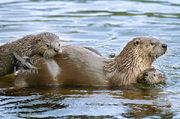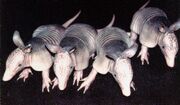
North American River otter mother with pups.
Embryonic Diapause[]
Embryonic Diapause, also known as delayed implantation, is a reproductive phenomenon found in about 100 different types of mammals. An animal that is undergoing the process of embryonic diapause has an embryo that does not immediately implant into the uterus after mating. It remains in a state of dormancy or inactivity. No development occurs during this time period as the embryo is not attached to the uterine wall and the gestation period may last up to almost one year. Delayed implantation is commonly found in 9-banded armadillos, Roe deer (but not all deer species) and the North American river otter.
The Cincinnati Zoo has been using fecal analysis on their North American River otters to determine the pregnancies and possibly birth dates of female otters in their collection. Because river otters have very poor reproductive success in captivity, scientists are able to use hormonal analysis to help with their reproductive success thereby increasing their breeding capabilities in captive populations.
Visit: http://cincinnatizoo.org/conservation/crew/crew-animal-research/otter/ for more information.

Chart graphing breeding, implantation and expected birth dates of North American river otters at the Cincinnati Zoo using hormonal analysis.
Types of Delayed Implantation[]
1. 1. Facultative diapause, also known as lactational delayed implantation, occurs when there is usually stress to the mother, such as not being completely done with lactation from a previous birth and now has another embryo trying to develop within her. An example of facultative diapause occurs in kangaroos and is initiated by the sucking stimulus from her offspring. The embryo will not attach onto the uterine wall and goes into diapause.
2. 2. Obligate diapause, also known as seasonal delayed implantation, occurs when the timing of the birth of the offspring is when environmental conditions are favorable. For example, 9-banded armadillos will typically give birth to 4 identical quadruplets when the weather is not at an extreme.

9-banded armadillo quadruplets.